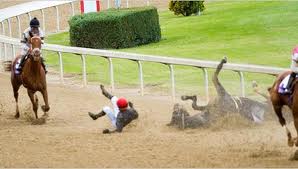The Controversial World of Thoroughbred Horse Racing

The increasingly controversial world of Thoroughbred horse racing has suffered some serious blows in past months. First, in March, People for the Ethical Treatment of Animals released its findings from an undercover investigation into the treatment of racehorses conducted in 2013 at Churchill Downs and Saratoga Raceway. The public was made aware of the misery and pain these young horses experience as they race with their excruciating lameness, masked by a complex cocktail of any of 180 drugs that have been found in their systems to hide injuries and enhance performance. NYSHA’s Dr. Holly Cheever was one of the equine veterinarians whose analysis of the video-graphed evidence was solicited to support the cruelty charges brought against the highly acclaimed and award-winning trainer, Steve Asmussen. Not only was it clear in the undercover footage that the young horse Nehro was crippled by his injuries and should be rested and not raced, but the contemptuous dislike of this poor colt revealed by his trainers, grooms, and handlers showed that they felt no empathy for his suffering, and in fact, found the use of electric shocks to produce bursts of speed highly amusing. Nehro died a few weeks later of a dramatic and excruciating case of colic — dead at the age of three, an adolescent who knew only pain during his brief career.

In the nick of time, the excitement over California Chrome’s chances to be the first Triple Crown winner in 36 years received a major share of welcome media attention: a new champion would be sure to restore some glory to this beleaguered sport. California Chrome won the first 2 races — the Kentucky Derby in Louisville and the Preakness Stakes in Baltimore — giving the racing world something to hope for after its long drought with no champions. However, in the Belmont Stakes in Elmont, NY, the star only achieved a disappointing tie for fourth, despite the thrashing he received from his jockey’s whip as he galloped to the finish line. He sustained a superficial injury (a cut on the heel of his right front leg) but in his owner’s heated post-race diatribe, the horse’s “failure” was blamed on his having run and overworked himself in the previous two races, while this year’s Belmont Stakes winner had not. In fact, California Chrome faced the same challenge that every one of the previous Triple Crown winners had faced, and Steve Coburn’s bitter and unsportsmanlike reaction was one more embarrassment for horseracing.
The lack of a winner for 36 years is very significant, underscoring many of the concerns about the changing standards for Thoroughbred breeding, the industry’s drug use, and current training protocols. Note in the chart below how many winners there have been from the Triple Crown’s inception in 1919 to the last winner in 1978: one winner in the teens, three winners in the 30’s, four winners in the ‘40’s, and three winners in the 70’s with none since. How can this impressive athletic achievement have been so possible in the past and so unattainable now? The answer lies in the changing philosophy of Thoroughbred breeding, driven by American greed and hunger for new records. In past decades, all horse breeds were developed to promote soundness, durability, and longevity as primary goals, and Thoroughbred breeding was no different. Even as recently as the 1980’s, the famous gelding John Henry raced through his ninth year — unheard of today — and was still a major winner in his last season. He lived to the ripe old age of 32, having won over $6,500,000 for his owners and with a long list of Thoroughbred racing’s most prestigious awards to his credit.
| Triple Crown Winners Since 1919 Inception to Present |
|
| Year | Horse |
| 1919 | Sir Barton |
| 1930 | Gallant Fox |
| 1935 | Omaha |
| 1937 | War Admiral |
| 1941 | Whirlaway |
| 1943 | Count Fleet |
| 1946 | Assault |
| 1948 | Citation |
| 1973 | Secretariat |
| 1977 | Seattle Slew |
| 1978 | Affirmed |
Today, Thoroughbreds never race to such an advanced age. The track breakdowns that are so common today — over 1,200 per year — were infrequent events in the past. Part of the blame for these statistics, which are far worse than occur internationally, can be attributed to the fast and unyielding surfaces of American tracks. As stated, Americans clamor for record-breaking performances, and those do not occur on the more forgiving turf surfaces seen in other countries. In addition, the changing aim of Thoroughbred breeding, favoring the more fragile but faster genetic lines, has inevitably driven the breakdown statistics to greater heights. There are far too many stresses inflicted on the present-day equine’s developing bones and ligaments, with too little chance for injury repair. Add to that the spiraling drug misuse that was only a minor element of horse racing in the early to mid-20th century, and you create a dangerous sport for horse and jockey, in which injured animals on performance-enhancing chemicals are forced to compete when medical advice would have them rested for weeks to months. Starting their rigorous training so young only adds to the damage and stress that their immature frames endure.
NYSHA encourages its members and the public annually to boycott our local Saratoga Racing season, and to educate co-workers and friends to do the same. In addition, we will continue to advise legislators on bills pertaining to animal cruelty issues; since the two-year legislative session has ended, we will be informing you next session of new or reintroduced bills to support or oppose in regard to Thoroughbred racing, as we strive for a law that will ban both horse slaughter in New York state and horse transportation through our state to slaughter beyond our borders. We thank you all for contacting your legislators on these important issues.
For a comprehensive look at the reality of horse racing, we urge you to read Joyce Anderson’s book, The Fancy Hat Veneer.
New York State Humane Association Humane Review, Vol. XXVIII No. 1, Spring/Summer 2014.